International education is entering a new phase
After recent changes to the immigration policy, many are predicting challenging times for Australia’s international student market. After being hit with the pandemic, the 408 visa disaster, and sudden visa refusals, the reputation of Australia’s international education sector has tarnished.
Effective from 1 July 2024, Australia will implement a significant policy change: visitors and Temporary Graduate (TGV) visa holders will no longer be able to apply for other visas while in Australia. This development marks a considerable shift in Australia’s migration landscape, with profound implications for international students, temporary workers, and the broader Australian economy.
The new policy aims to tighten the migration framework and ensure that visa applicants adhere to their initial visa conditions. This change is intended to curb the misuse of visitor and TGV visas as pathways to long-term residency, which has been a growing concern among policymakers. By requiring these visa holders to apply for new visas offshore, the government seeks to enhance the integrity of the visa system and prioritise applicants who are genuinely committed to their stated purpose of visit. The education sector may face a decline in enrollment rates, particularly from students who prefer to secure their study plans while onshore. Universities and colleges could see reduced revenue, potentially impacting their financial stability and capacity to invest in quality education and infrastructure.
In the 2023-24 program year to 31 December 2023, there were 195,934 student visas granted – a decrease of 40% when compared with the same period in 2022-23 (283,940 visas granted). In the 2023-24 program year to 31 December 2023, there were 56,802 visas granted to applicants located in Australia – a decrease of 51% when compared with the same period in 2022-23 (117,009 visas granted). There were 139,132 visas granted to applicants located outside Australia – a decrease of 17% when compared with the same period in 2022-23 (166,931 visas granted).
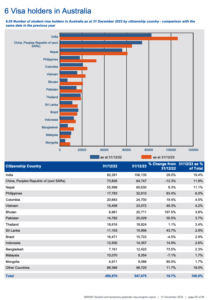
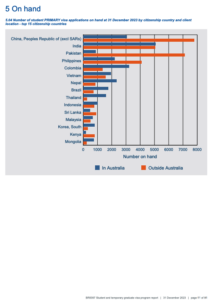
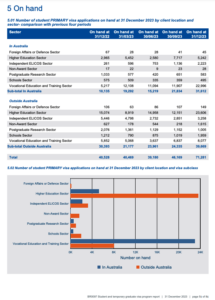
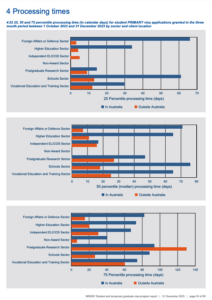
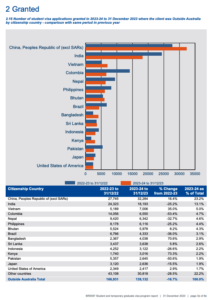
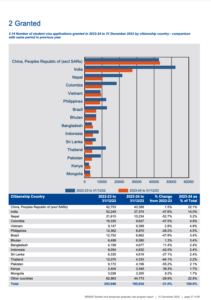
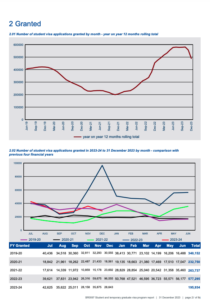
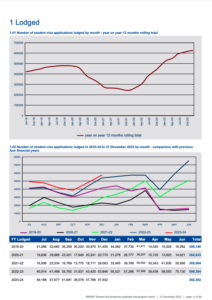
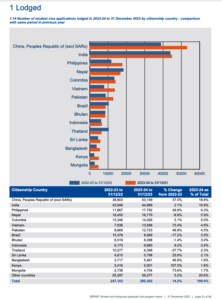
In the 2023-24 program year to 31 December 2023, the number of visas granted to applicants located outside Australia decreased by: 4% (to 88,049) in the Higher Education Sector; 44% (to 19,222) in the ELICOS Sector; and 37% (to 14,161) in the VET Sector – when compared with the same period in 2022- 23.
In the 2023-24 program year to 31 December 2023, the top five source countries for visa grants were: China (43,389); India (27,374); Nepal (10,234); Colombia (9,627); and Vietnam (9,399). Visa grants to citizens of China and Vietnam increased by 1.5% and 2.8% respectively when compared with the same period in 2022-23. Visa grants to citizens of the other three countries decreased by 47.6% (India); 52.7% (Nepal); and 47.5% (Colombia). In the 2023-24 program year to 31 December 2023, TGV grants decreased by 52% when compared with the same period in 2022-23.
The broader economic implications are substantial. International students contribute significantly to the Australian economy through tuition fees, living expenses, and part-time work. A potential decrease in student numbers could result in a reduction in these economic contributions, affecting local businesses and industries reliant on student expenditure.
Moreover, the restriction on TGV holders applying for other visas while in Australia may impact the availability of skilled labor. Many TGV holders, after gaining Australian qualifications and work experience, transition to skilled visas, filling critical gaps in the labor market. This new policy could hinder this talent pipeline, exacerbating skills shortages in various sectors.
#AustraliaVisaPolicy #MigrationChanges #InternationalStudents #EducationSector #TemporaryGraduateVisa #SkilledMigration #EconomicImpact #VisaReform #StudyInAustralia #StudentVisa #AustraliaEconomy #CulturalExchange #TourismImpact #PolicyShift #AustraliaMigration #VisaProcessing #BrainDrain #SkilledLabor #HigherEducation #MulticulturalAustralia





Leave A Comment